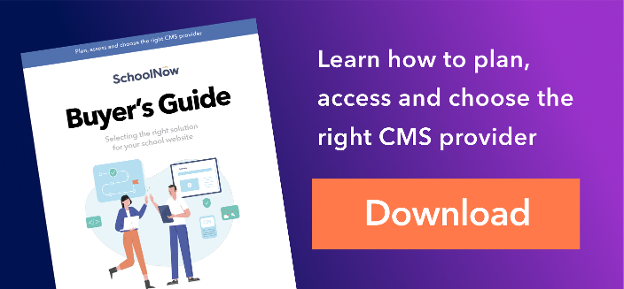Does your school’s website need a new web hosting provider? Maybe the web hosting contract is up, or it’s just not connecting with your students, parents, and community like it could. Does it lack the functionality you need to effectively communicate information? It could just look outdated and not reflect your school’s image.
All of those are great reasons to consider a new website. It’s a primary source of school information for many in your audience and a key driver in your school's overall communications effectiveness. If your website's not doing its job, it can have many adverse effects.
If you’re a private school, your website is often the first step in the recruiting process. If you’re a public school, your website and how you use it can make or break a tax levy campaign. Whatever your kind of school – public, private, charter – your website is a critical tool in fostering engagement and cooperation between students, teachers, and parents.You may feel some urgency to get your new site up and running. However, your website is too important to rush the decision as to which website hosting provider (content management system) to choose.
Rather than hastening the process, it’s worth it to take your time and make the right decision. Interview numerous school website hosting providers. Take their platforms for a test drive. Contact their other clients for feedback. Do your due diligence so you can be sure that you have the website and service provider to meet all your needs.
Before you simply start sending out RFPs or getting quotes, use the following checklist for selecting the right school website hosting providers to guide your search:
1. Take a strategic approach.
Your website is too important for a snap decisions. You need a website that satisfies all stakeholders, whether they’re teachers, administrators, parents, or students. Just as you have lesson plans to steer learning, transportation plans to get the students to and from school, a game plan for the varsity football team, a web communications plan as part of a larger school communications plan is critical. Here are a few things you can do to make sure you’re taking a strategic approach:
- Assemble a selection committee. You don’t have to make this decision alone. In fact, you shouldn’t make it alone. If you’re the webmaster, or IT director, or school communications director and the decision is largely yours, surround yourself with other key people. Put together a committee to vet website hosting providers. The committee should include high-ranking administrators, like the superintendent, along with representatives from your communications, technology, and enrollment departments. You may also include a teacher or two.
- Define your goals. What do you want the website to do? Recruit new students? Get parents more engaged? Connect your school to the surrounding community? It’s okay if you want it to accomplish multiple things, but you should prioritize these goals. Create a written mission of why your website exists and what it should accomplish.
- Gather feedback about your current site. Conduct a survey of your parents, teachers, and students. What do they like about your current site? What would they like to see improved? The feedback from these surveys may shed new light on your priorities. I guarantee you’ll identify some glaring needs.
2. Review the provider’s technological offerings.
Don’t get blown away by aesthetics. Rather, dig into the technology behind the site. Aesthetics can always be changed, but a technologically inferior site will be hard to recover from. After all, you want a site that will last for years. You don’t want it to be outdated as soon as it launches.
There are two primary technological concerns that you should consider:
- Is it responsive? A responsive website is one that can adapt its appearance to fit any device. So, no matter whether your audience is accessing your site through their cell phone, tablet, or computer, your site will still load properly. This is increasingly important these days as the number of mobile users hitting your website is growing rapidly.w
- Does it have interoperability? This means that the site works the same in any browser and operating system. There was a time when Internet Explorer was the dominant web browser, but according to statcounter, IE’s popularity is waning, while Google’s Chrome product continues to gather pace. Today, people use a wide variety of browsers and operating systems, so you want to be sure that your website will work on all of them.
3. Test the site’s ease-of-use.
Ideally, your site will probably be managed by multiple parties with varying degrees of technical know-how. You’ll have administrators adding content and managing calendars. You may have coaches updating team information pages. Your teachers will have their own mini-sites within the larger website. School secretaries, lunchroom ladies – the list goes on.
It’s unrealistic, of course, to expect all of those individuals to become website experts. But it’s not too much to ask of your website provider that it accommodates the non-techie user. You need a site that is easy to use and edit. The best way to do that is with a content management system (CMS) that allows users to edit the website by simply typing in what they want to see, much like they would in a word processor.
Content management systems also allow for easy design changes, social media sharing, and the ability to embed links, photos, and videos. Every provider has a different CMS with unique characteristics and features. You should ask each provider if you can test their CMS out to see whether it will be easy for your staff to adjust to.
4. Consider design options.
Will you be able to get a website that looks unique, professional, and aesthetically pleasing? Can they match the site’s design to your school colors and other branding elements?
Most providers base their designs off templates, but then customize certain elements to make the design specific to you. This is a benefit to you because it saves you time and money. However, you also don’t want a website that looks generic and that duplicates the appearance of other sites.
You should ask the provider to show you how many different design templates they use. How many features can be customized? Can incorporate some specific designs or do you have to stick to the templates? If you want some aspects of the templates changed, how long will it take and what will be the additional cost?
5. Review their support and training.
At some point, you will have questions about your website. You may not be able to figure out how to implement a certain feature. Your team may be unsure about how to update their pages within the site. You may need get a communication out quickly and have some issues sharing it on social media.
When these issues pop up, what are your options? Does the provider have a dedicated support line? Can you talk to someone on the phone or is it only through email? What are their hours of operation?
Also, check to see how they’ll train you and your staff when the site is implemented. Do they do it in person, over the phone, or with some kind of interactive seminar? Do they train you and your team or do they simply train you and leave the rest of the training in your hands?
6. Are they secure and reliable?
By secure and reliable, I'm talking more about their technical security issues. You may have sensitive information in your site’s database, including student and teacher names, as well as home addresses and even social security numbers. Securing that sensitive information should be a high priority. Additionally, you want to be sure that your site is free from hackers and that it will stay online at all times.
What security options do they offer? How do they backup your site’s data and information? If their servers crash, what are your options? These may seem like unlikely scenarios, but it’s still important to ask the questions.
7. Talk to their other customers.
Finally, the last thing you’ll want to do is get the full story from the providers’ other customers. The provider will likely give you a few references. Those are probably the ones that they know will provide positive feedback. Go a little deeper: ask for a couple of additional names, too.
Ask the customers how long they’ve been with the provider, why they switched, and whether they’ve been happy. Also, ask about areas where they’d like to see improvement. Talking to customers will give you a good idea of what the provider’s experience is like after their solution has been implemented.
Your website is a significant investment, both in terms of time and money. It’s worth it to take the time to do your due diligence and make sure you get the right solution. Follow these steps and you’ll likely end up with a good match and the perfect provider – and website – for your school.
Topics: School Districts Private schools Website design Content management Security
About the author
Marketing director and content strategist for SchoolNow, Jay’s a former school public relations specialist who’s helped businesses, schools and colleges use the power of communications to improve their image, generate support, and optimize relationships. Reach him at jay@schoolnow.com.
.png?width=64&height=63&name=Group%20(4).png)
.png?width=66&height=64&name=Group%20(5).png)
.png?width=56&height=60&name=Group%20(6).png)
.png?width=66&height=52&name=Group%20(7).png)
.png?width=56&height=56&name=Group%20(9).png)
.png?width=59&height=52&name=Group%20(10).png)



